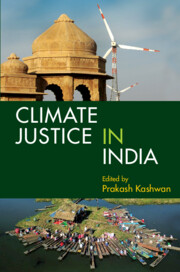Book contents
- Frontmatter
- Contents
- List of Poems and Artworks
- List of Tables
- List of Figures
- List of Abbreviations
- Preface and Acknowledgements
- 1 Introduction: Climate Justice in India
- 2 Urban Climate Justice in India
- 3 How Just and Democratic Is India’s Solar Energy Transition?: An Analysis of State Solar Policies in India
- 4 Extractive Regimes in the Coal Heartlands of India: Difficult Questions for a Just Energy Transition
- 5 Climate Justice Implications of the Relationship between Economic Inequality and Carbon Emissions in India
- 6 Climate Action Plans and Justice in India
- 7 Social Mobilizations for Climate Action and Climate Justice in India
- 8 Reimagining Climate Justice as Caste Justice
- 9 Intersectional Water Justice in India: At the Confluence of Gender, Caste, and Climate Change
- 10 Realizing Climate Justice through Agroecology and Women’s Collective Land Rights
- 11 Conclusion: Pathways to Policies and Praxis of Climate Justice in India
- About the Editor and Contributors
- About the Poets and Artists
- Index
4 - Extractive Regimes in the Coal Heartlands of India: Difficult Questions for a Just Energy Transition
Published online by Cambridge University Press: 03 November 2022
- Frontmatter
- Contents
- List of Poems and Artworks
- List of Tables
- List of Figures
- List of Abbreviations
- Preface and Acknowledgements
- 1 Introduction: Climate Justice in India
- 2 Urban Climate Justice in India
- 3 How Just and Democratic Is India’s Solar Energy Transition?: An Analysis of State Solar Policies in India
- 4 Extractive Regimes in the Coal Heartlands of India: Difficult Questions for a Just Energy Transition
- 5 Climate Justice Implications of the Relationship between Economic Inequality and Carbon Emissions in India
- 6 Climate Action Plans and Justice in India
- 7 Social Mobilizations for Climate Action and Climate Justice in India
- 8 Reimagining Climate Justice as Caste Justice
- 9 Intersectional Water Justice in India: At the Confluence of Gender, Caste, and Climate Change
- 10 Realizing Climate Justice through Agroecology and Women’s Collective Land Rights
- 11 Conclusion: Pathways to Policies and Praxis of Climate Justice in India
- About the Editor and Contributors
- About the Poets and Artists
- Index
Summary
Introduction
It is now accepted that the future of coal will be decided in the developing world. Even as Western countries transition away from coal, increased production and consumption of coal in India and China have meant that the share of coal in global energy production has remained constant for the past 40 years, despite attempts at decarbonization (Edwards 2019). Nevertheless, the West continues to produce high per capita emissions compared to developing nations (Lazarus and van Asselt 2018). In response, India has asserted its rights to equitable energy access in the international arena (Jaitly 2021). At the same time, questions of intra-country equity complicate India's position, with many arguing that India must pursue low-carbon pathways to protect its poor and vulnerable groups (Bidwai 2012).
After Independence, coal became an enduring symbol of national development in India (Lahiri-Dutt 2014). The coal industry has deep political roots, engaging powerful stakeholders at different levels (Bhattacharjee 2017). In recent years, coal investments have lost their appeal due to unrest over their environmental impacts as well as a dynamic downward trend in the demand for thermal power (Rajshekhar 2021). Even so, production targets for the state-owned Coal India Limited (CIL) – responsible for over 80 per cent of India's coal production – were increased to 1 billion metric tonnes by 2024. The central government is actively looking to sell more coal blocks to raise money, despite the lukewarm response to recent coal block auctions. Coal imports have simultaneously increased, engendering a new coastal coal geography controlled by private actors (Oskarsson et al. 2021). That renewables cannot substitute for coal, despite policy support from the state, is accepted. Analysts expect coal-fired generation to continue to grow to meet electricity demand growth even if 350 gigawatt (GW) of renewable energy (RE) capacity is installed by 2030 (Tongia and Gross 2019). New energy forms, including renewables, are, historically speaking, energy ‘additions’ rather than ‘transitions’ (Oskarsson et al. 2021). Importantly, this perception is not typical of India alone, as the global energy system remains locked into high coal energy use in the midst of an RE boom (Oskarsson et al. 2021).
- Type
- Chapter
- Information
- Climate Justice in India , pp. 74 - 97Publisher: Cambridge University PressPrint publication year: 2024
- Creative Commons
- This content is Open Access and distributed under the terms of the Creative Commons Attribution licence CC-BY-NC 4.0 https://creativecommons.org/cclicenses/
- 1
- Cited by

